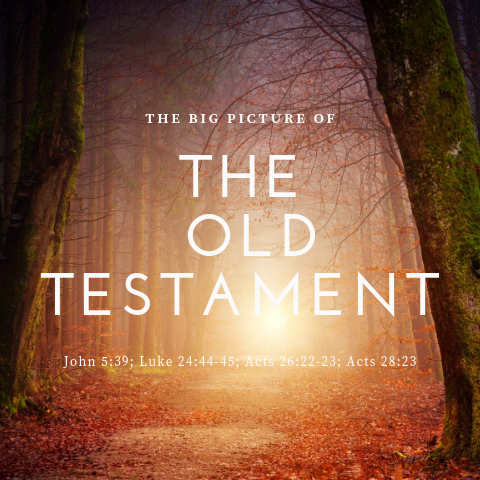 Note: The following is from our Wednesday Bible studies.
Note: The following is from our Wednesday Bible studies.
Why the Old Testament? Ceremonial washings. Unusual (to modern ears) customs. Risqué details of scandalous sin. Thousands upon thousands of bloody animal sacrifices. Poetry and songs. Rare stories. Long prophetic books with strange imagery. Long (did we say long!) genealogies. But, rest assured there is great purpose in this collection of 39 books. The Old Testament is Preparatory. It is a stage-setter. The stage is being set for the person and work of Jesus Christ. Through ceremonies, prophecies, prominent people, sacrifices and more, extensive preparation is being made for the revelation of Christ. New Testament passages such as these make this point crystal clear: John 5:39; Luke 24:44-45; Acts 26:22-23; Acts 28:23.
Therefore, we are not to read the Old Testament as a complete revelation in and of itself. (This is not at all to suggest that the Old Testament is uninspired by God or is fallible or contains error! No, it is the pure word of God). We are not intended to interpret and understand it apart from the New Testament. The Old and New have been produced, designed and weaved together by the Holy Spirit. In the New Testament we find that many prominent Old Testament themes and figures are referenced and given more explanation. Some examples among many: Abraham (and Sarah), Noah, Moses, David, Elijah, Passover, Sacrifices, Temple and much more. The New Testament expands on and sheds light on the Old Testament; the Old Testament supports and enhances the meaning of the New Testament in a way that would be impossible apart from the Old Testament. It is remarkable how many times New Testament authors make a statement and then buttress it with a quotation from the Old Testament.
The Old Testament reveals the character and nature of a holy God. It graphically shows the dark and pervasive corruption of the sin of humanity. But, it also highlights the purpose and promise of God to bring salvation. The Bible itself has what we might call The Big Story. This true story is that the sovereign God glorifies Himself by redeeming sinners through His Eternal Son, Jesus Christ.That is a one-liner description of Scripture (not perfect, but hopefully adequate). We also recognize that The Big Story includes the proper response to Christ of repentance and faith, the Christian life, the church, the glories of eternity to come and more. But, all those themes center around, and are related to the person and work of Christ. So, as we read the Old Testament, we should often ask ourselves, “How is this related to Christ and His work?” In other words, “How does this fit with The Big Story?”
One example: when you are reading through Leviticus and trying to get your head around meticulous details of what is clean and what is unclean, of leprosy regulations and even certain instruction on very personal details of hygiene, you may wonder how in the world you should receive soul-edification from such passages. Much could be said. But in short, the contents of Leviticus were God’s way of using such meticulous attention to detail to reveal just how perfectly holy He is, how utterly sinful we are, and that the only way to be clean and accepted with Him is through the sacrifice that He ordains. The New Testament shouts loudly and clearly that this once-and-for-all sacrifice is realized in Jesus Christ, that dirty sinners who come to Him are cleansed and can therefore approach God with peace, confidence and joy. On a practical level, it is also teaching that God intends for His people to be holy, set apart from the pollution of sin. The New Testament further teaches us that true holiness is not found in obsessing over hygiene and temporary purification ceremonies, but in sincere trust, love and obedience to God’s word. Hopefully, this brief snapshot is helpful in illustrating how both Testaments are knit together as God’s invaluable revelation.
Finally, while some of the commands God gave to Israel do not apply to Christians today (because God intended many of the religious ceremonies He instituted in ancient Judaism only for that particular era), there is much instruction that does apply directly and indirectly to believers today. There are great warnings against sin, tragic examples of the consequences of disobedience alongside many positive examples of faith, perseverance and worship. Note these passages: 1 Cor. 10:1-12; Romans 15:4. Therefore, the Old Testament should lead us to worship a holy and merciful God, rejoice in the work of Jesus, hate our sins and motivate us to happily live a life of godliness each day.
While the Old Testament admittedly has sections that are difficult to grasp, I hope that from this introduction you can see that studying through it is well worth our time and diligent effort. May God’s Spirit illuminate our hearts and minds to greater understanding.
Questions:
- True or False: “The Old Testament is preparatory.”
- It sets the stage for the person and work of _______________________.
- Is the Old Testament a complete revelation in and of itself? __________.
- Which statement is accurate: “The Old and New Testaments are contradictory and unrelated” or “The Old and New Testaments enhance and complement one another. They harmonize together to tell us The Big Story.”
- What is The Big Story?
- The Old Testament should lead us to ___________ a holy and merciful God, rejoice in the work of ___________, hate our __________ and motivate us to happily live a life of _____________ each day.


